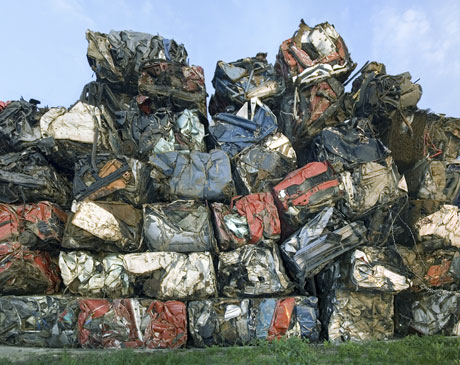
Over the next few months, nearly 750,000 clunkers are going to be scrapped. Not dismantled, mind you, but smashed and melted into their base, formative materials.
Whether or not this is good government policy we'll leave to our friends at The Economist. And others can debate the relative environmental effects; for instance, some claim the energy expended to build a new car, no matter how mileage-frugal it is, far outweighs any potential carbon footprint savings realized when compared with keeping an old one on the road.
In the past, when various states have proposed or enacted their own versions of cash-for-clunkers bills, in order to get older, higher-polluting cars off the road, the collector car community has been nearly unanimous, and quite vocal, in its disapproval. The spectre of Hemi 'Cudas or Ferrari 250 Testa Rossas being shipped to the crusher is dangled before us, as if the dismantler were a villain from a slasher film striking down only the loveliest victims.
These claims lack credibility, as even scrapyard operators tend to be a savvy group, and if a collectible muscle car or exotic showed up bound for destruction, it would surely be rescued prior to its death by flattening.
Silent Spring for crappy cars
As to the current cash-for-clunkers bill, which includes cars from 1984 to 2008 that get poor gas mileage, the collector car community has been silent. And for good reason. Can you name a single collectible car, worth less than $4,500, built from 1984 to the current day? Edmunds
.com singles out the 1984-86 Buick Regal T-type Turbo, the 1985-89 BMW 635CSi, and the 1987-89 Porsche 911 Carrera as cars from the pre-1990 era that, while they qualify as clunkers, are collectible.
If you have owned one of the above cars for more than a year and are happy to get a $4,500 credit for it, we can assume you've probably just gotten a horrendous repair estimate from a mechanic, and your car is not exactly in Pebble Beach condition.
Some industry associations claim that by scrapping crappy cars, the government is depriving repair shops the opportunity to generate revenue by working on these cars as they break down, which of course they are going to do with increasing frequency. Not much sympathy around the SCM office for this approach. Others claim that it is unfortunate to deprive high school shop classes (do they still have these?) of a parts supply-a perspective that does have merit.
These arguments aside, 20 years from now, at local concours, will there be a dearth of entries in the 1984-2008 classes? Will we have our own automotive "Silent Spring," with a generation of cars wiped off the face of the freeways? Will circles of collectors sit long into the night passing around playing cards with their favorite Jaguar XJ6 on them and sighing, "Remember when?"
Fractions
Not likely, and for two primary reasons. First, the number of cars potentially involved in cash for clunkers, while large in and of itself, is actually a tiny fraction of all the vehicles sold in the U.S. during that period. According to published statistics, approximately 360m cars and trucks were sold in the U.S. from 1984 to 2008. And 750,000 potentially crushed cars is just 0.2% of that total. Which means that nearly 100% of the cars built during that period will either still be on the road or will have died natural, non-clunker-assisted deaths. (No foreseeable shortage of 1987 Mustangs; we are so relieved.)
Second, dealers, if presented a clunker trade-in that is worth more than $4,500, have the option simply to purchase the car outright from the customer, for $4,500 or more, and apply that toward the customer's new car.
For instance, if someone shows up with a base-model 1991 Alfa 164 showing 250,000 miles and with nearly every electrical system malfunctioning-which is their normal condition these days-then the clunker allowance of $4,500 makes sense. But if it is a low-mileage 1995 24-valve Q-model in exceptional condition, with a retail value north of $10,000, the dealer can simply buy the car and sell it for more later.
Of course, anyone who is willing to take $4,500 for a perfect Q has probably made some other stupid financial decisions along the way, and he has other issues to deal with.
No need to worry
In the end, from a collector's point of view, the clunker bill is irrelevant. We're not going to see a stream of 1992 Porsche 911 Turbos headed to the smashing yard, nor are 1989 Ferrari 328s going to clog Hyundai dealerships, waiting to be traded in against Accents.
Looking at it in the simplest way, it will get some not-very-good cars off the road. The average cash value of the traded-in clunkers to date has been $1,475. That's not exactly the value profile of a collectible car.
SCM for your friends
Our largest source of new readers has always been referrals from current subscribers. You are a thoughtful, committed group and we appreciate your active involvement with the magazine. On page 66 of this issue, you'll find a postage-paid card that allows you to send me the contact information for gearheads you think might like to get a sample copy of SCM, with no strings attached. Or, go to www.sportscarmarket.com/friends and enter the data there.
Ultimately, it is your subscriptions that keep our analysts' "boots on the ground" at auctions all over the world. Through your continued subscriptions and renewals, we have been able to print more pages of auction reports this year than we had originally forecast. Thank you again for your continued support.